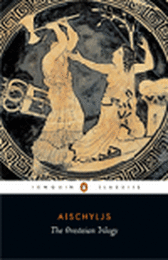Synopsis
The Oresteian Trilogy - Agamemnon & The Choephori & The Eumenides
Published by Penguin
Poisoning a house's life
With darkness, treachery and strife' (47)
Aeschylus (525c.456 BC) set his great trilogy in the immediate aftermath of the Fall of Troy, when King Agamemnon returns to Argos, a victor in war. Agamemnon depicts the hero's discovery that his family has been destroyed by his wife's infidelity and ends with his death at her callous hand. Clytemnestra's crime is repaid in The Choephori when her outraged son Orestes kills both her and her lover
The Eumenides then follows Orestes as he is hounded to Athens by the Furies' law of vengeance and depicts Athene replacing the bloody cycle of revenge with a system of civil justice. Written in the years after the Battle of Marathon, The Oresteian Trilogy affirmed the deliverance of democratic Athens not only from Persian conquest, but also from its own barbaric past
Philip Vellacott's verse translation makes this eternal dramatic masterpiece accessible for the modern reader. In his introduction, he examines the historical context and the literary style of the plays
 $16.99
$16.99